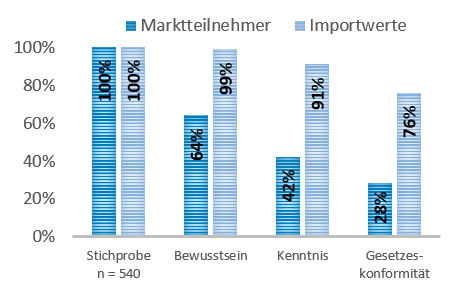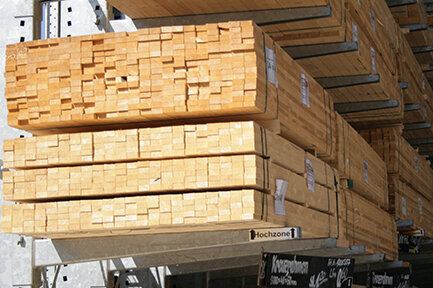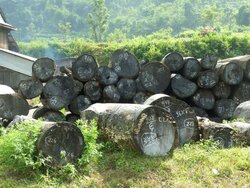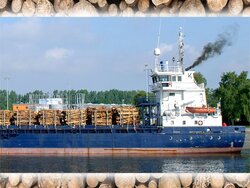Expertise
Implementation and effects of the EU Timber Regulation
Margret Köthke | 27.11.2023
The EU Timber Regulation is intended to curb the trade in illegally harvested timber. Timber market analyses and company surveys show the discrepancy between the scope of regulation and its implementation.
Illegal logging is one of the major global causes of deforestation and forest degradation. Trade in illegally harvested timber and products made from it has negative social and economic impacts - in both producer and consumer countries.
Despite international efforts to combat illegal logging, the problem remains widespread. Due to the illegal nature of the problem, accurate figures on the amount of illegal logging are not available. According to calculations by the Thünen Institute, illegal logging worldwide in 2009 ranged from 100 to nearly 300 million cubic meters of raw wood - almost 10-20 % of the total global timber harvest. The Thünen Institute calculated that in 2009, 2-5 % of timber imports to Germany and 6-13 % of timber imports to the EU came from illegal sources.
Causes of illegal logging
In a cross-country comparison, the Thünen Institute investigated the causes of illegal logging. The results show that, in addition to physical-geographical characteristics, a number of factors related to the degree and speed of a country's economic-institutional development are significantly associated with illegal logging. These include, for example, economic growth, the degree of government accountability, rule of law, and the presence of corruption. Armed conflict and population pressure, on the other hand, have a smaller impact. The study's findings are also of interest for possible improvements to existing policies to combat illegal logging.
EU Timber Regulation to combat illegal logging
The EU Timber Regulation (EUTR) is an important European Union measure to combat illegal logging worldwide. Since 2013, it has banned the placing of illegally harvested timber or timber products on the EU internal market.
However, the EUTR does not apply to all wood products. The annex to the EUTR lists exactly which goods the regulation applies to. The focus is naturally on
- Raw timber and classic timber products such as sawn timber, plywood or carpentry and joinery,
- pulp from wood as well as
- Paper, cardboard and goods made from them.
- In addition, some wooden furniture and prefabricated wooden houses are listed.
Certain product groups such as seating furniture, brushes and paintbrushes, tools, charcoal or waste paper and printed paper are not yet affected by the regulation. Against this background, the question arises as to how many of all imported wood products are covered by the regulation.
What efficiency does the EUTR actually achieve?

Calculations by the Thünen Institute show that in 2020 about 87 % of the imported timber volumes into the EU has been covered by the EUTR. However, the EUTR did not apply to wood quantities of approx. 20 million m³ (measured in roundwood equivalents) in 2020. This value is distributed almost equally between wood and paper products.
Looking at the different product groups, raw materials show a higher degree of coverage than processed products or even finished goods. The largest share of imports of non-accounted products into the EU is accounted for by recovered paper, the product group "other articles of wood" (including charcoal), furniture (especially chairs) and printed media.
In Germany, about 27,000 companies that import wood or wood products are subjected to the EUTR. In 2018, the Thünen Centre of Competence conducted a survey among German importers on the implementation of the EUTR. It showed that small companies outside the timber sector in particular are often unaware of the EUTR.
Only 42 % of the 540 market participants surveyed were aware of the EUTR and that the directive also applies to them. However, these companies together import 91 % of all EUTR products (in terms of total value in euros). 28 % of operators reported having the mandatory due diligence system in place (see figure).
These results reflect that mainly large companies in the wood sector are aware of and implement the EUTR. Small companies and companies from outside the industry are often not aware of the EUTR at all. However, these small companies make up the majority of importing market participants.
Publications
- 0
Köthke M, Weimar H (2022) Trade in wood-based products in the EU27 - wood content and coverage by the current EUTR and the proposed regulation on deforestation-free value chains. Braunschweig: Johann Heinrich von Thünen-Institut, 52 p, Thünen Working Paper 193, DOI:10.3220/WP1655114210000
- 1
Bösch M (2021) Institutional quality, economic development and illegal logging: a quantitative cross-national analysis. Eur J Forest Res 140:1049-1064, DOI:10.1007/s10342-021-01382-z
- 2
Köthke M (2020) Auswirkungen der Europäischen Holzhandelsverordnung auf Importeure von Holzerzeugnissen in Deutschland - Design und Ergebnisse einer Befragung. Braunschweig: Johann Heinrich von Thünen-Institut, 62 p, Thünen Working Paper 143, DOI:10.3220/WP1587970140000
- 3
Köthke M (2020) Geringer EUTR-Kenntnisstand unter Marktteilnehmern aus Deutschland : Marktteilnehmer aus dem Holzsektor kannten die EUTR signifikant häufiger. Holz Zentralbl 146(9):180
- 4
Köthke M (2020) Implementation of the European Timber Regulation by German importing operators: An empirical investigation. Forest Pol Econ 111:102028, DOI:10.1016/j.forpol.2019.102028
- 5
Janzen N, Weimar H (2016) Market coverage of the EUTR - what share of wood imports into the EU is covered by the EUTR? Drewno 59(197), DOI:10.12841/wood.1644-3985.C08.02
- 6
Weimar H, Janzen N, Dieter M (2015) Market coverage of wood imports by the EU Timber Regulation. Hamburg: Johann Heinrich von Thünen-Institut, 63 p, Thünen Working Paper 45, DOI:10.3220/WP1440577266000
- 7
Dieter M, Englert H, Weimar H (2012) Holz aus illegalem Einschlag in Deutschland und der EU : Status-Quo-Bericht zum Inkrafttreten des Holzhandels-Sicherungs-Gesetz (Holz-SiG). Holz Zentralbl 137(10):257-259
- 8
Dieter M, Englert H, Weimar H (2012) Wood from illegal harvesting in EU markets: estimations and open issues. Landbauforsch Appl Agric Forestry Res 62(4):247-254
https://literatur.thuenen.de/digbib_extern/bitv/dn051377.pdf
- 9
Dieter M (2009) Analysis of trade in illegally harvested timber: accounting for trade via third party countries. Forest Pol Econ 11(8):600-607, DOI:10.1016/j.forpol.2009.08.003





![[Translate to English:] Logo des Bundesministerium für Ernährung und Landwirtschaft](/media/allgemein/logos/BMEL_Logo.svg)